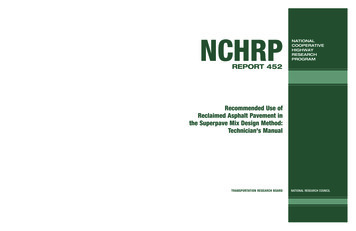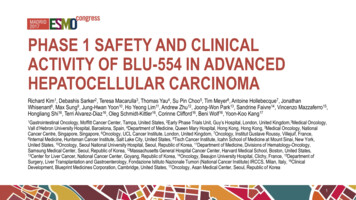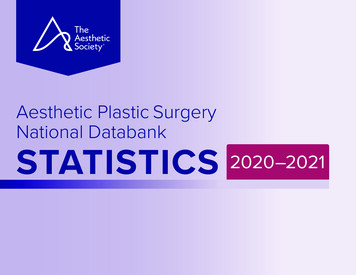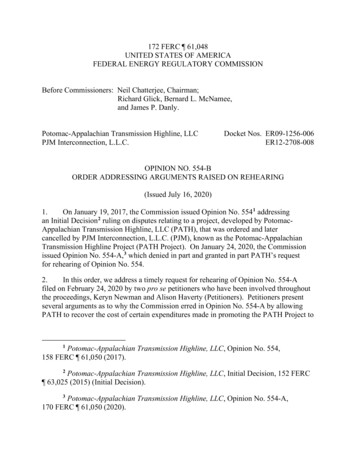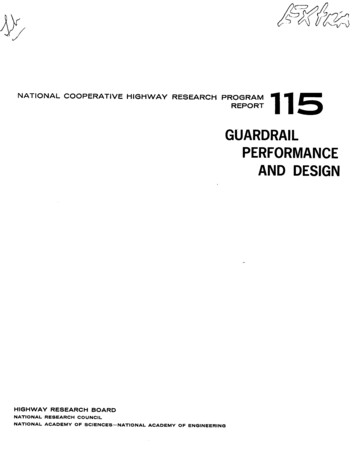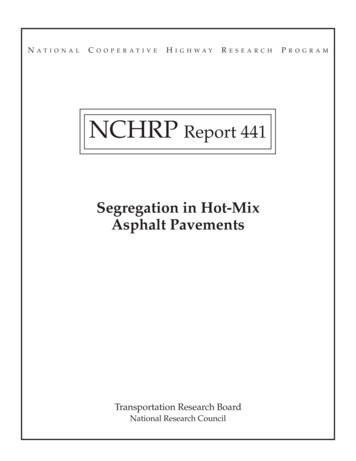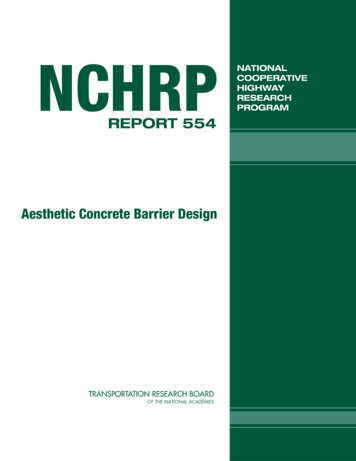
Transcription
NCHRPREPORT 554Aesthetic Concrete Barrier DesignNATIONALCOOPERATIVEHIGHWAYRESEARCHPROGRAM
TRANSPORTATION RESEARCH BOARD EXECUTIVE COMMITTEE 2005 (Membership as of November 2005)OFFICERSChair: John R. Njord, Executive Director, Utah DOTVice Chair: Michael D. Meyer, Professor, School of Civil and Environmental Engineering, Georgia Institute of TechnologyExecutive Director: Robert E. Skinner, Jr., Transportation Research BoardMEMBERSMICHAEL W. BEHRENS, Executive Director, Texas DOTALLEN D. BIEHLER, Secretary, Pennsylvania DOTLARRY L. BROWN, SR., Executive Director, Mississippi DOTDEBORAH H. BUTLER, Vice President, Customer Service, Norfolk Southern Corporation and Subsidiaries, Atlanta, GAANNE P. CANBY, President, Surface Transportation Policy Project, Washington, DCJOHN L. CRAIG, Director, Nebraska Department of RoadsDOUGLAS G. DUNCAN, President and CEO, FedEx Freight, Memphis, TNNICHOLAS J. GARBER, Professor of Civil Engineering, University of VirginiaANGELA GITTENS, Vice President, Airport Business Services, HNTB Corporation, Miami, FLGENEVIEVE GIULIANO, Director, Metrans Transportation Center, and Professor, School of Policy, Planning, and Development,USC, Los AngelesBERNARD S. GROSECLOSE, JR., President and CEO, South Carolina State Ports AuthoritySUSAN HANSON, Landry University Professor of Geography, Graduate School of Geography, Clark UniversityJAMES R. HERTWIG, President, CSX Intermodal, Jacksonville, FLGLORIA JEAN JEFF, Director, Michigan DOTADIB K. KANAFANI, Cahill Professor of Civil Engineering, University of California, BerkeleyHERBERT S. LEVINSON, Principal, Herbert S. Levinson Transportation Consultant, New Haven, CTSUE MCNEIL, Professor, Department of Civil and Environmental Engineering, University of DelawareMICHAEL R. MORRIS, Director of Transportation, North Central Texas Council of GovernmentsCAROL A. MURRAY, Commissioner, New Hampshire DOTMICHAEL S. TOWNES, President and CEO, Hampton Roads Transit, Hampton, VAC. MICHAEL WALTON, Ernest H. Cockrell Centennial Chair in Engineering, University of Texas, AustinLINDA S. WATSON, Executive Director, LYNX—Central Florida Regional Transportation AuthorityMARION C. BLAKEY, Federal Aviation Administrator, U.S.DOT (ex officio)JOSEPH H. BOARDMAN, Federal Railroad Administrator, U.S.DOT (ex officio)REBECCA M. BREWSTER, President and COO, American Transportation Research Institute, Smyrna, GA (ex officio)GEORGE BUGLIARELLO, Chancellor, Polytechnic University, and Foreign Secretary, National Academy of Engineering (ex officio)J. RICHARD CAPKA, Acting Administrator, Federal Highway Administration, U.S.DOT (ex officio)THOMAS H. COLLINS (Adm., U.S. Coast Guard), Commandant, U.S. Coast Guard (ex officio)JAMES J. EBERHARDT, Chief Scientist, Office of FreedomCAR and Vehicle Technologies, U.S. Department of Energy (ex officio)JACQUELINE GLASSMAN, Deputy Administrator, National Highway Traffic Safety Administration, U.S.DOT (ex officio)EDWARD R. HAMBERGER, President and CEO, Association of American Railroads (ex officio)DAVID B. HORNER, Acting Deputy Administrator, Federal Transit Administration, U.S.DOT (ex officio)JOHN C. HORSLEY, Executive Director, American Association of State Highway and Transportation Officials (ex officio)JOHN E. JAMIAN, Acting Administrator, Maritime Administration, U.S.DOT (ex officio)EDWARD JOHNSON, Director, Applied Science Directorate, National Aeronautics and Space Administration (ex officio)ASHOK G. KAVEESHWAR, Research and Innovative Technology Administrator, U.S.DOT (ex officio)BRIGHAM MCCOWN, Deputy Administrator, Pipeline and Hazardous Materials Safety Administration, U.S.DOT (ex officio)WILLIAM W. MILLAR, President, American Public Transportation Association (ex officio)SUZANNE RUDZINSKI, Director, Transportation and Regional Programs, U.S. Environmental Protection Agency (ex officio)ANNETTE M. SANDBERG, Federal Motor Carrier Safety Administrator, U.S.DOT (ex officio)JEFFREY N. SHANE, Under Secretary for Policy, U.S.DOT (ex officio)CARL A. STROCK (Maj. Gen., U.S. Army), Chief of Engineers and Commanding General, U.S. Army Corps of Engineers (ex officio)NATIONAL COOPERATIVE HIGHWAY RESEARCH PROGRAMTransportation Research Board Executive Committee Subcommittee for NCHRPJOHN R. NJORD, Utah DOT (Chair)MICHAEL D. MEYER, Georgia Institute of TechnologyJ. RICHARD CAPKA, Federal Highway AdministrationROBERT E. SKINNER, JR., Transportation Research BoardJOHN C. HORSLEY, American Association of State HighwayMICHAEL S. TOWNES, Hampton Roads Transit, Hampton, VAand Transportation OfficialsC. MICHAEL WALTON, University of Texas, Austin
NATIONAL COOPERATIVE HIGHWAY RESEARCH PROGRAMNCHRP REPORT 554Aesthetic Concrete Barrier DesignD. LANCE BULLARD, JR.NAUMAN M. SHEIKHROGER P. BLIGHREBECCA R. HAUGJAMES R. SCHUTTBEVERLY J. STOREYTexas Transportation InstituteCollege Station, TXS UBJECT A REASHighway and Facility DesignResearch Sponsored by the American Association of State Highway and Transportation Officialsin Cooperation with the Federal Highway AdministrationTRANSPORTATION RESEARCH BOARDWASHINGTON, D.C.2006www.TRB.org
NATIONAL COOPERATIVE HIGHWAY RESEARCHPROGRAMSystematic, well-designed research provides the most effectiveapproach to the solution of many problems facing highwayadministrators and engineers. Often, highway problems are of localinterest and can best be studied by highway departmentsindividually or in cooperation with their state universities andothers. However, the accelerating growth of highway transportationdevelops increasingly complex problems of wide interest tohighway authorities. These problems are best studied through acoordinated program of cooperative research.In recognition of these needs, the highway administrators of theAmerican Association of State Highway and TransportationOfficials initiated in 1962 an objective national highway researchprogram employing modern scientific techniques. This program issupported on a continuing basis by funds from participatingmember states of the Association and it receives the full cooperationand support of the Federal Highway Administration, United StatesDepartment of Transportation.The Transportation Research Board of the National Academieswas requested by the Association to administer the researchprogram because of the Board’s recognized objectivity andunderstanding of modern research practices. The Board is uniquelysuited for this purpose as it maintains an extensive committeestructure from which authorities on any highway transportationsubject may be drawn; it possesses avenues of communications andcooperation with federal, state and local governmental agencies,universities, and industry; its relationship to the National ResearchCouncil is an insurance of objectivity; it maintains a full-timeresearch correlation staff of specialists in highway transportationmatters to bring the findings of research directly to those who are ina position to use them.The program is developed on the basis of research needsidentified by chief administrators of the highway and transportationdepartments and by committees of AASHTO. Each year, specificareas of research needs to be included in the program are proposedto the National Research Council and the Board by the AmericanAssociation of State Highway and Transportation Officials.Research projects to fulfill these needs are defined by the Board, andqualified research agencies are selected from those that havesubmitted proposals. Administration and surveillance of researchcontracts are the responsibilities of the National Research Counciland the Transportation Research Board.The needs for highway research are many, and the NationalCooperative Highway Research Program can make significantcontributions to the solution of highway transportation problems ofmutual concern to many responsible groups. The program,however, is intended to complement rather than to substitute for orduplicate other highway research programs.Note: The Transportation Research Board of the National Academies, theNational Research Council, the Federal Highway Administration, the AmericanAssociation of State Highway and Transportation Officials, and the individualstates participating in the National Cooperative Highway Research Program donot endorse products or manufacturers. Trade or manufacturers’ names appearherein solely because they are considered essential to the object of this report.NCHRP REPORT 554Project 22-19ISSN 0077-5614ISBN 0-309-08849-6Library of Congress Control Number 2005938042 2006 Transportation Research BoardPrice 34.00NOTICEThe project that is the subject of this report was a part of the National CooperativeHighway Research Program conducted by the Transportation Research Board with theapproval of the Governing Board of the National Research Council. Such approvalreflects the Governing Board’s judgment that the program concerned is of nationalimportance and appropriate with respect to both the purposes and resources of theNational Research Council.The members of the technical committee selected to monitor this project and to reviewthis report were chosen for recognized scholarly competence and with dueconsideration for the balance of disciplines appropriate to the project. The opinions andconclusions expressed or implied are those of the research agency that performed theresearch, and, while they have been accepted as appropriate by the technical committee,they are not necessarily those of the Transportation Research Board, the NationalResearch Council, the American Association of State Highway and TransportationOfficials, or the Federal Highway Administration, U.S. Department of Transportation.Each report is reviewed and accepted for publication by the technical committeeaccording to procedures established and monitored by the Transportation ResearchBoard Executive Committee and the Governing Board of the National ResearchCouncil.Published reports of theNATIONAL COOPERATIVE HIGHWAY RESEARCH PROGRAMare available from:Transportation Research BoardBusiness Office500 Fifth Street, NWWashington, DC 20001and can be ordered through the Internet Printed in the United States of America
The National Academy of Sciences is a private, nonprofit, self-perpetuating society of distinguished scholars engaged in scientific and engineering research, dedicated to the furtherance of science and technologyand to their use for the general welfare. On the authority of the charter granted to it by the Congress in1863, the Academy has a mandate that requires it to advise the federal government on scientific and technical matters. Dr. Ralph J. Cicerone is president of the National Academy of Sciences.The National Academy of Engineering was established in 1964, under the charter of the National Academy of Sciences, as a parallel organization of outstanding engineers. It is autonomous in its administrationand in the selection of its members, sharing with the National Academy of Sciences the responsibility foradvising the federal government. The National Academy of Engineering also sponsors engineering programsaimed at meeting national needs, encourages education and research, and recognizes the superior achievements of engineers. Dr. William A. Wulf is president of the National Academy of Engineering.The Institute of Medicine was established in 1970 by the National Academy of Sciences to secure theservices of eminent members of appropriate professions in the examination of policy matters pertainingto the health of the public. The Institute acts under the responsibility given to the National Academy ofSciences by its congressional charter to be an adviser to the federal government and, on its own initiative,to identify issues of medical care, research, and education. Dr. Harvey V. Fineberg is president of theInstitute of Medicine.The National Research Council was organized by the National Academy of Sciences in 1916 to associatethe broad community of science and technology with the Academy’s purposes of furthering knowledge andadvising the federal government. Functioning in accordance with general policies determined by the Academy, the Council has become the principal operating agency of both the National Academy of Sciencesand the National Academy of Engineering in providing services to the government, the public, and thescientific and engineering communities. The Council is administered jointly by both the Academies andthe Institute of Medicine. Dr. Ralph J. Cicerone and Dr. William A. Wulf are chair and vice chair,respectively, of the National Research Council.The Transportation Research Board is a division of the National Research Council, which serves theNational Academy of Sciences and the National Academy of Engineering. The Board’s mission is to promoteinnovation and progress in transportation through research. In an objective and interdisciplinary setting,the Board facilitates the sharing of information on transportation practice and policy by researchers andpractitioners; stimulates research and offers research management services that promote technicalexcellence; provides expert advice on transportation policy and programs; and disseminates researchresults broadly and encourages their implementation. The Board’s varied activities annually engage morethan 5,000 engineers, scientists, and other transportation researchers and practitioners from the public andprivate sectors and academia, all of whom contribute their expertise in the public interest. The program issupported by state transportation departments, federal agencies including the component administrations ofthe U.S. Department of Transportation, and other organizations and individuals interested in thedevelopment of transportation. www.TRB.orgwww.national-academies.org
COOPERATIVE RESEARCH PROGRAMS STAFF FOR NCHRP REPORT 554ROBERT J. REILLY, Director, Cooperative Research ProgramsCRAWFORD F. JENCKS, Manager, NCHRPCHARLES W. NIESSNER, Senior Program OfficerEILEEN P. DELANEY, Director of PublicationsNATALIE BARNES, EditorBETH HATCH, EditorNCHRP PROJECT 22-19Field of Design—Area of Vehicle Barrier SystemsMARK J. BLOSCHOCK, Texas DOT (Chair)KEITH ROBINSON, California DOTNORMAN W. GARRICK, University of ConnecticutDON J. GRIPNE, Trinity Industries, Inc., Olympia, WARICHARD D. LAND, California DOTDOUGLAS E. MCCLURE, South Carolina DOTRICHARD D. POWERS, FHWAHOWARD R. RESSEL, New York State DOTPRISCILLA TOBIAS, Illinois DOTHARRY W. TAYLOR, JR., FHWA LiaisonSTEPHEN F. MAHER, TRB Liaison
FOREWORDBy Charles W. NiessnerStaff OfficerTransportation ResearchBoardThis report contains guidelines for aesthetic treatment of concrete safety shape barriers. The report will be of particular interest to design and safety practitioners withresponsibility for roadside safety improvements.The increasing application of context-sensitive design solutions for highway projectshas created a national need for aesthetic improvement of typical highway features.Requests for concrete barrier treatments and bridge rails that contribute to the overallaesthetic experience are increasing. Concrete barriers (e.g., New Jersey, F-shapes,single-slope, and vertical-face designs) are often the barriers of choice in urban and suburban environments. Many transportation agencies and communities have expressed adesire for aesthetic treatments for these standard shapes.To date, there has been limited evaluation to determine which aesthetic treatments aresafe and practical. Designers need guidance regarding the safety implications of aesthetic treatments for concrete barriers.Under NCHRP Project 22-19, “Aesthetic Concrete Barrier and Bridge Rail Design,”the Texas Transportation Institute developed design guidelines for aesthetic safety shape(New Jersey and F-shape profile) concrete barriers.In Phase I, the research team identified the features and methods that contribute to theaesthetics of longitudinal traffic barriers and the aesthetic experience provided by theroadway. The research team conducted a literature review, surveyed U.S. and foreignsources for examples of aesthetic longitudinal traffic barriers, and reviewed existing testresults and ongoing research to assess the crashworthiness of the aesthetic concrete barriers and see-through bridge rails.At an interim meeting, the project panel and researchers agreed that the work todevelop specific designs for see-through bridge rails should not continue. Also, after theinitiation of this project, a California Department of Transportation (Caltrans) studydeveloped guidelines for single-slope and vertical-face concrete barriers. Thus the focusof research under NCHRP Project 22-19 shifted to developing guidelines for aesthetictreatment of safety shape barriers only.In Phase II, the research team conducted a finite element simulation pilot study, performed model validation, and developed a surrogate measure of occupant compartmentdeformation. Further finite element simulations were performed to develop preliminarydesign guidelines in terms of asperity depth, width, and angle of inclination. Based onthese preliminary guidelines, a crash test plan was developed, in which the outcome ofone test determined the configuration evaluated in a subsequent test. Results of the crashtests performed were used in conjunction with the preliminary guidelines developedthrough simulation to develop final design guidelines for aesthetic treatment of safetyshape concrete barriers.For the convenience of an aesthetic designer, guidelines developed for safety shapebarriers in this research and the guidelines previously developed by the FHWA and Cal-
trans for stone masonry guardrails and for single-slope and vertical-face concrete barriers, respectively, were consolidated into a single set of design guidelines.Designers now have sufficient guidelines to apply aesthetic treatments to varioustypes of barriers.
CONTENTS1CHAPTER 1 IntroductionResearch Problem Statement, 1Research Objective, 12CHAPTER 2 State of the PracticeReview of the Literature, 2Summary of Literature Review, 3Survey of State DOTs, 4Survey of U.S. and International Crash Test Laboratories, 516CHAPTER 3 Considerations for Developing an Aesthetic BarrierDeveloping a Definition for Aesthetics, 16Changing the Aesthetics of a Longitudinal Concrete Traffic Barrier, 17Design Techniques, 17Factors Affecting Design, 17Applications, 18Viewer Preference Survey, 23Assessment, 29Aesthetic Design Discussion, 2930CHAPTER 4 Aesthetic Concrete Barrier Design Guideline DevelopmentObjective, 30Overall Summary of the Development Approach, 3032CHAPTER 5 Simulation and Preliminary Aesthetic Design GuidelineDevelopmentIntroduction, 32Pilot Study and Finite Element Model Validation, 33Generalized Surface Asperity Definition, 47Preliminary Aesthetic Design Guidelines, 4856CHAPTER 6 Crash Testing and Further Evaluation of Preliminary AestheticDesign GuidelinesCrash Test Conditions and Evaluation Criteria, 56Selection Considerations for Crash Test Configurations, 57Crash Test 1 (474630-1), 59Crash Test 2 (474630-2), 59Crash Test 3 (474630-3), 60Crash Test 4 (474630-4), 60Crash Test 5 (474630-5), 62Crash Test 6 (474630-6), 62Crash Test 7 (474630-7), 6466CHAPTER 7 Final Design GuidelinesGuidelines for Aesthetic Surface Treatments of Safety ShapeConcrete Barriers, 66Comparison with Guidelines for Single-Slope and Vertical-Face Barriers andStone Masonry Guardwalls, 6670CHAPTER 8 Conclusions71REFERENCESA-1APPENDIX Guidelines for Aesthetic Barrier Design
1CHAPTER 1INTRODUCTIONRESEARCH PROBLEM STATEMENTIn response to local expectations and the traveling public,there is a national need for aesthetic improvement of typicalhighway features. Requests for barrier treatments and bridgerails that contribute to the overall aesthetic experience areincreasing. Research will assist owners in responding todesign requests for aesthetic improvements to transportationsystems.Concrete barriers (e.g., New Jersey, F-shape, and singleslope, and vertical-face designs) are often the barriers of choicein urban and suburban environments. Many agencies and communities have expressed a desire for aesthetic treatments forthese standard shapes. To date, there has been limited evaluation to determine which aesthetic treatments are safe and practical. Current standards do not provide guidelines to improvethe appearance of concrete barriers.Local communities and agencies are also demandingincreasingly that state DOTs provide bridge rails with anenhanced “see-through” appearance. Existing designs do notfully meet the desire of the public for a see-through appearance. However, the use of innovative designs and materialsmay result in the development of aesthetic bridge rails withimproved view spaces.Designers need guidelines for aesthetic treatments of concrete barriers and additional options for see-through bridgerails.RESEARCH OBJECTIVEThe initial objectives of this research were to (1) assemblea collection of examples of longitudinal traffic barriers exhibiting aesthetic characteristics; (2) develop design guidelinesfor aesthetic concrete roadway barriers; and (3) develop specific designs for see-through bridge rails.Following the submittal of the project interim report andthe project panel members’ meeting with the researchers, thescope of the project and research objectives were modified toonly (1) assemble a collection of examples of longitudinal traffic barriers exhibiting aesthetic characteristics and (2) developengineering design guidelines for aesthetic surface treatmentsof concrete safety shape barriers (e.g., New Jersey and F-shapeprofiles). Design guidelines for single-slope and verticalface concrete barriers had been finalized after the initiationof this project in a California DOT study that is discussed inthis report.This report summarizes the entirety of the findings of theproject, including work performed prior to the modificationof the scope and objectives. Chapters 2 and 3 focus on thework performed by the researchers prior to the modificationof the scope and objectives. Chapter 2 summarizes (1) thestate of the practice pertaining to the features and methodsthat contribute to the aesthetics of longitudinal barriers andthe aesthetic experience provided by the roadway; (2) the literature reviewed; and (3) the use of aesthetic longitudinaltraffic barriers and treatments as identified through a surveyof U.S. and foreign sources. Many aesthetic barrier exampleswere provided by transportation organizations from aroundthe world and are presented in Chapter 2. Chapter 3 focusesprimarily on barrier form and how it is perceived by thedriver in its environment. The chapter defines aesthetics anddiscusses assessment, factors, and techniques for changingthe aesthetic character of longitudinal concrete barriers. Inaddition, Chapter 3 discusses a viewer preference survey thatwas performed. Chapter 4 describes the development approachfor the aesthetic concrete barrier design guideline. Chapter 5describes the finite element simulation pilot study, modelvalidation, and development of a surrogate measure of occupant compartment deformation. In addition, Chapter 5 presents preliminary design guidelines based on finite elementsimulation. Chapter 6 presents the selection considerationsand results of the full-scale crash tests performed in supportof the finite element simulations and the development of thefinal design guidelines. The final design guidelines for aesthetic safety shape concrete barrier design are presented inChapter 7.
2CHAPTER 2STATE OF THE PRACTICEREVIEW OF THE LITERATUREAesthetics is a branch of philosophy dealing with thetheory and perception of beauty and the psychological responses to it. How and why things are perceived as aesthetically pleasing is a subjective matter, yet many standards forbeauty or aesthetics exist. In terms of highways and theircomponents, Leonhardt(1) discusses the design of a structureas containing many variables that affect aesthetic visual quality. In agreement with many other designers and engineers,the basics of design are function, form, color, and texture.Yet other design characteristics, especially for linear structures such as a concrete barrier or bridge rail, include proportion, symmetry, rhythm, repetition, and contrast. Harmonious proportion is a valuable component of linear design.The manner in which various parts of the structure (height,width and depth, masses and voids, closed and open surfaces,light and dark created by sun and shadow) relate creates thecharacter of the structure. Tang, in his “Philosophical Basisfor Chinese Bridge Aesthetics” describes the concept of“yin and yang” in aesthetics. “The one form has no realitywithout the other, they are in opposition, comparison, harmony and succession.”(2) The structures express their unityby opposition as they reflect, complement, and transformone another.Although the aesthetic component of design is the mostvisible to the user, few guidelines exist. Highway construction generally follows the safety and economy rulefirst. The Federal Highway Administration (FHWA) realizes that aesthetics and context-sensitive design are important factors in the design-making process and should beplaced “. . . on an equal basis with mobility, safety and economics.”(3) Safety is the primary concern in highway design,yet safety and aesthetics are not mutually exclusive. “Thesuccessful inclusion of highway aesthetics can be achievedfor any project by giving consideration to these five “C’s” ofdesign: context, comprehensiveness, cost, contractibility,and community.”(4)The basic philosophical intent of creating highway aesthetics is to balance the safety and mobility needs of thetransportation systems with the human need for a sense ofcommunity and aesthetic satisfaction. Both the FHWA andthe American Association of State Highway and Transportation Officials (AASHTO) are working to develop the issuesof context-sensitive design and the incorporation of thismindset into the highway design process, from geometricdesign of the roadways to the aesthetic components withinand extending beyond the roadway.(5)With the exception of planting design, guidance on whenand how to use specific aesthetic elements or treatments in thehighway environment is virtually nonexistent. The question ofwhen, where, and why to use color, pattern, textures, art, lighting, and so forth appears to be generally left to individual orgroup decision processes and is done in ad hoc manner. Thetype of criteria used in these decision processes (other thansafety and cost issues) is not well established. Experience ofthe authors suggests that the most common criteria are probably consensus, embodied by the phrase: “Whatever everybodywill agree to.” Evidently this is a common occurrence.(6)Many highway design scenarios exist where selection ofaesthetic elements and treatments may not pose any significantconflicts or issues. Obviously, however, since the roadway hasa potentially hazardous element to its environment, a moreclear set of criteria would be desirable to aid designers in theirdecision making. Two areas of study that offer a frameworkfor roadway aesthetics design are environmental psychologyand human factors. Each relates to the other in that both useresearch from both fields.Environmental psychology seeks to understand and describe humanity’s relationship with the environment. Subsetsof this field include environmental cognition and assessmentand environmental design. These disciplines study visual perception and communication, as well as emotional responses,and how these things affect decision making in real-worldenvironments.(7) This information also applies to decidingwhat is important in terms of cognition and the prediction ofchoices or preferences by an individual.(6) A large part of thestudy in this field attempts to describe this relationship interms of scenic quality, our preferences for a certain aesthetic,the level of satisfaction we gain from a setting, or our comfortlevels during certain activities. Much of the literature involveshuman responses to the natural environment and how positiveexperiences can be maximized, particularly in urban settings.Of particular interest in terms of aesthetics is the work donein the areas of driver perception,(8) the visual quality of thedriving environment,(9) the effectiveness of signed communication,(10,11) and driver performance related to visibility conditions.(12) These and other studies find that as the roadway
3becomes more cluttered, the conspicuousness of traffic control devices worsened.(13) This condition is termed visualcomplexity and occurs when the background and the numberof objects in the scene combine to the point of creating aninformation load that is excessive, confusing, or ambiguous.(14) The size of objects and their edge contrast are important determinants of conspicuity.(13) Contrast and luminanceof the object with respect to the background and the surrounding area have a great impact on the perceptibility ofobjects.(11,15) Brighter colors are recommended as a tool toincrease both conspicuity and contrast.(10,16,17)The studies cited deal with making specific elements morevisible (in particular, critical traffic control or driver performance information) but do not apply this approach to aesthetics. A basis is developed in a study from Japan.(8) This3-year study looked at the issue of visual complexity in theview of the roadscape as a whole.The study was specifically looking at the degree of visualimage perception at the stage before cognition. In otherwords: “what you see” before “what you know.” It found thatthere is a hierarchical structure of articulation for elementsversus backgrounds. The pavement is registered first, elementsforming the skyline such as buildings or trees appear second,and roadside elements—including utility poles, pedestrianbridges, advertisement—are noticed last.This hierarchy is established by virtue
NCHRP REPORT 554 Research Sponsored by the American Association of State Highway and Transportation Officials in Cooperation with the Federal Highway Administration SUBJECT AREAS Highway and Facility Design Aesthetic Concrete Barrier Design D. LANCE BULLARD, JR. NAUMAN M. SHEIKH ROGER P. BLIGH REBECCA R. HAUG JAMES R. SCHUTT BEVERLY J. STOREY
